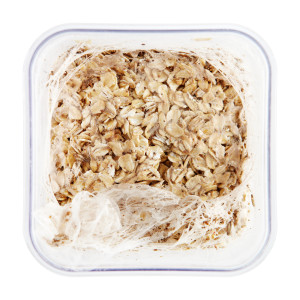So you see little brown moths in your kitchen?
The most common moth in the kitchen and pantry is the Indian Meal Moth. This insect is a small gray moth (3/8 inch long) with copper or bronze ends on the wings. Moths have complete metamorphosis, meaning they have the following developmental stages: Egg, Larva (caterpillar), Pupa (cocoon), and Adult.
We all have a box of pancake mix or a bag of pasta sitting on a pantry shelf well past the recommended usage date. Most of the time, this forgotten or overlooked box or package is where the moth problem starts. Plastic bags and cardboard boxes of other pantry staples are quickly bored through and before long, an all-out infestation is about to blossom and drive you temporarily nuts.
Where so the moths come from?
Simple answer… the grocery store. Take a peek over toward where the birdseed is kept next time you are leisurely browsing through the pet food aisle. Should you be patient, you will see a few moths flying around. These are most likely Indian Meal Moths and they infest broken grain products at the distribution warehouses and grocery retailers. Female moths will deposit a few eggs onto spilled product or open containers while the product is on a shelf. The product is purchased and taken into your home where it sits on the shelf long enough for the life cycle to complete and another moth to fly out into your pantry. This moth breeds and seeks a suitable place to start the new generation. This is how an infestation begins.
What do they infest?
Coarsely ground grains, cereals, flours, nuts, herbs, dried fruits, pet foods, and even dried ornamental flower arrangements. Areas where spilled flour or pet food may accumulate can provide a great hidden food source for hungry caterpillars. Once a population becomes established, the number of items found in a home susceptible to infestation is staggering. The caterpillars spin silk as they feed and will create webbing inside the package they are infesting. Finding and eliminating the source(s) of infestation is a must for control. Good product rotation will help with stored product pest management, whether beetles, weevils, or moths.
Biology of Control
Since infestation source identification is so important to control, a brief understanding of biology is needed. Indian Meal Moth generally primarily infest broken grain products such as cereal, flours, crackers, or pasta. Whole seed, dried fruits, and nuts are generally infested after the more desirable broken grain products are rotated out or unavailable. The eggs are very small, ½ mm, and extremely difficult to spot. The caterpillars are much easier to identify through the webbing present in infested items. Caterpillars are sometimes seen out of the food product as they crawl to a place to pupate. The pupae, or cocoons, are generally under the edge of shelves, around the pantry door frame, or the corner between the wall and ceiling. The cocoon will be a small gray mass of silk that is easily spotted by dedicated eyes. The adult moths fly at dusk and through the night and can be very numerous. The adults do not feed and only live a short time.
Storage of food products in airproof heavy plastic or metal containers will protect against many stored product pest issues. Certain foods, such as organic grains or coarse ground organic flours should be stored in the freezer if not used quickly. Bird seed and pet food should also be stored in a sealing container outside of the kitchen and preferably outside of the living space of the house.
 What do I look for?
What do I look for?
Caterpillars
Control begins with inspection. A thorough clean-up of the pantry is needed to start the process. Look over the pantry shelves and find food packages containing broken grain products with tell-tale webbing or small round holes through the packaging. Find these items and dispose of them and then take the bag out of the home. Vacuum up any spilled flour or food product on the shelves or floor of the pantry or cabinets.
Pupae (Cocoons)
Look for cocoons in the edges of the cabinets and pantry, under shelves, and corners of the walls. A vacuum crevice tip works well for removing the pupae and stopping the new adults from emerging.
Adult Moths
Pheromone traps are widely available as Pantry Pest Traps and work well to capture moths as they fly. Each trap covers a specific area and if too many are placed in a small area, the moths will not be able to locate an individual trap. A flyswatter in the evening is also an effective means of controlling adults. Fogging insecticides are usually not the answer and should really only be used in extremely severe infestations.
When should I call a professional?
Light to moderate Indian Meal Moth and other Stored Product Pest infestations can generally be managed by the resident with a little dedication and patience. If patience is not your strongest suite, Entex professionals and entomologists can significantly shorten the control cycle. A trained eye and knowledge of potential secondary food sources can shorten an outbreak by a month or two. If you cannot get a handle on the situation comfortably, Entex entomologists are glad to answer questions over the phone or completely and effectively manage the issue for you. You have questions, we have answers – Scientifically Sure answers.